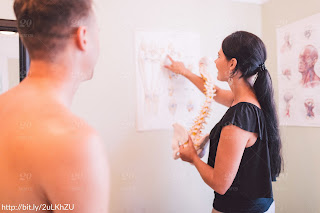Image courtesy
Focus Fitness
Earlier this year I watched a video
on Canadian trainer Omar Isuf’s YouTube channel where he interviewed DPT and
20x world record breaking (as of the time I’m writing this) powerlifter Stefi
Cohen. As a physiotherapist who competes in powerlifting Stefi is definitely
someone whom I greatly idolize for her insane athletic accomplishments as well
as the success she’s had getting her DPT and starting a fantastic performance
gym & company with her fiancée Hayden.
In
the video Omar asked Stefi about her thoughts on strength training as a means
of preventing sports injuries and Stefi discussed that it may be or may not be
a fad. She also brought up the fact that we seem to shift from fad to fad with
common trends (over the last 2 decades) in sports injury reduction including
(but not limited to) bracing, transverse abdominnis exercises, movement
screening & functional movement, workload ratio and other topics. So it
raises the question – is strength training a fad in sports injury prevention?
First the term “injury prevention” is a misnomer and
should be changed to sports injury reduction as we can never truly prevent
injuries. There are some injuries; particularly contact injuries; that you
can’t prevent no matter what – short of completely removing yourself or your
athletes from the sport.
Now that that’s out of the way let’s look at the evidence
….
A 2018 systematic review and meta-analysis in the British
Journal of Sports Medicine (free access link here) showed that a
10% increase in strength training volume reduced sports injury risk by 4%. It’s
a heterogenous paper with many different sports & many different protocols
… but it gives us something to work with.
But with this evidence comes a few caveats, one more
opinion based and one more evidence based
#1: Past a certain level of strength; which is sport
& athlete specific; increasing strength comes with a point of diminishing
returns. The stronger you get the harder it is to get stronger; from an eating,
sleeping, rehab, and recovery perspective; plus there is (in my anecdotal
opinion) a higher risk of injury as you push the envelope of maximal strength. For
most athletes (excluding powerlifters, Olympic lifters & strongmen); past a
certain level of strength; more time could be spent improving other components
of athletic performance such as speed training, conditioning, and most
importantly skill work over trying to get your athletes stronger.
#2: Sports injuries are multifactorial and can be
influenced by training workload (and
fluctuations in workload), sleep, psychosocial
factors, nutrition,
genetics, previous injury, movement
skill, anatomy & anthropometrics, and other factors. As such we
have to take a multi-faceted approach to sports injury reduction rather than
simply relying on a single cure-all. I plan to elaborate on these topics on
more detail in future articles for both my site and for Mash Elite Performance.
I hope this brief article provides some food for thought
on a complex and popular topic. As always – thanks for reading.



